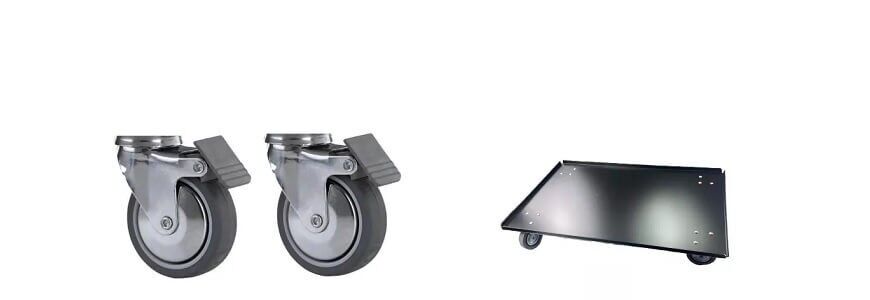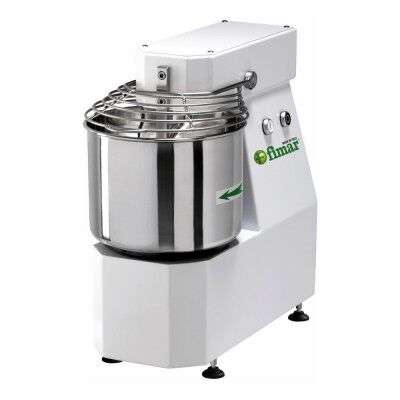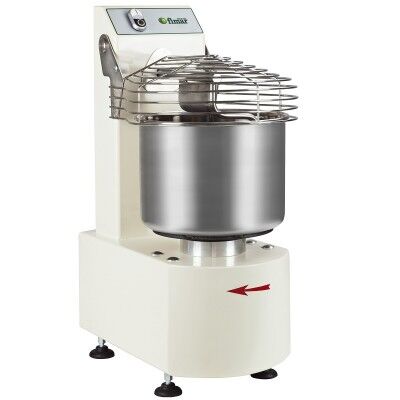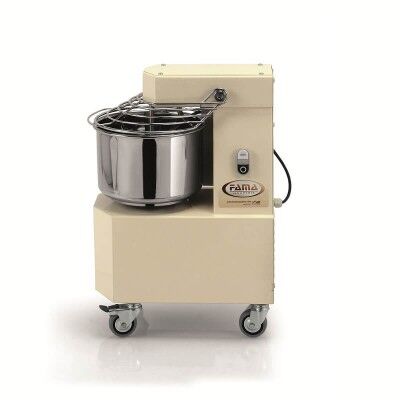Spiral Mixer: Buying Guide
Are you looking for the right spiral mixer for your needs? This guide has been written with the aim of accompanying you on a conscious selection journey.
We will see how these machines work, what different types are available, how to choose them based on your needs, and how to use them optimally to achieve the best dough results.
Additionally, you will find practical tips for maintaining and cleaning your professional spiral mixer.
Get ready to impress your customers with bread, pizza, pastries, and many other creations.
What are spiral mixers?
Spiral mixers are professional machines used for processing medium and high-consistency doughs, particularly suitable for producing bread, pizza, and fresh pasta. Their distinctive element is the spiral-shaped mixing arm, which rotates inside a bowl, allowing for a uniform, well-mixed, and oxygenated dough.
Compared to planetary mixers, spiral mixers provide greater kneading force, ideal for working tough and resistant doughs, such as those with a high gluten or hydration content. Moreover, the specific shape of the spiral arm ensures a vigorous action on the dough, giving it the typical elastic and airy structure.
Spiral mixers are available in various versions, differing in capacity, power, and technical features. Choosing the most suitable model depends on specific production needs, in terms of the amount of dough to be processed and the frequency of use.
For professional use, robust and high-performance spiral mixers with powerful motors and high-quality construction materials are recommended.
How do spiral mixers work?
The operating principle of spiral mixers is based on the combined action of two main elements: the spiral mixing arm and the bowl.
The mixing arm rotates on its own axis inside the bowl, performing both a rotational and translational movement. The spiral shape of the arm is designed to replicate the manual movement of an expert baker, ensuring uniform processing of the dough in every part.
During rotation, the spiral continuously lifts, stretches, and folds the dough, promoting gluten development, oxygenation, and the formation of a strong and elastic gluten network. The spiral action also gives the dough its characteristic airy structure, which is crucial for achieving baked goods with an optimal texture.
In some mixer models, the rotation speed of the mixing arm is adjustable based on dough characteristics such as hydration and consistency and the processing phase.
The bowl, generally made of stainless steel, serves to contain the dough during processing and facilitate its movement thanks to its rounded shape. The bowl’s capacity varies depending on the mixer model, with production capacities ranging from 5 to 150 kg of dough per batch.
In summary, spiral mixers use a mechanical movement designed to faithfully replicate manual dough processing, ensuring uniform mixing, optimal gluten development, and proper oxygenation to achieve high-quality baked goods.
Types of Spiral Mixers: An Overview for Professionals
Spiral mixers are categorized into different types based on construction and functional characteristics that make them suitable for specific production needs. Choosing the most suitable model depends on several factors, which we will analyze below.
Fixed-Head Spiral Mixer:
- The most common type, suitable for medium-sized bakeries and for producing various types of dough.
- The bowl is fixed to the machine body, with capacities usually ranging from 5 to 150 kg of processed dough.
- They offer a good price-performance ratio and are available in both 230V single-phase and 380V three-phase power options.
Tilting-Head Spiral Mixer:
- Allows for easy dough extraction thanks to the tilting head.
- Particularly suitable for producing large quantities of dough, making handling easier.
High-Hydration Spiral Mixer:
- Designed for processing doughs with a high water content, such as those for bread or gourmet pizzas.
- Often equipped with variable speed, and some models feature an inverter motor that allows variable adjustment of the spiral's rotation speed to achieve better dough mixing and oxygenation.
Optional Features and Accessories for Enhanced Functionality
- Grated Lid: A special bowl cover that prevents the operator from coming into contact with moving parts while allowing ingredients to be added without stopping the mixer.
- Speed Variator: Allows adjustment of the mixing arm speed according to different dough processing stages.
- Timer: Enables setting the kneading time for greater precision and consistency in results.
- Removable Bowl: Facilitates dough extraction and bowl cleaning after processing.
- Motor Overload Protection: A thermal protection system that activates when the motor windings reach critical temperatures due to excessive strain.
How to Choose the Right Spiral Mixer
Selecting the right professional spiral mixer for a bakery or pizzeria requires careful evaluation of several factors to find the model that best suits specific production needs and ensures optimal performance.
Key Criteria to Consider:
- Production Capacity:
- Evaluate the average daily dough volume to choose a machine with the right capacity.
- Consider potential seasonal production peaks or future business expansions.
- Opt for a model with slightly higher capacity than current needs to ensure future flexibility.
- Type of Dough:
- Spiral mixers are suitable for medium and high-consistency doughs, such as those for bread, pizza, and fresh pasta.
- For highly hydrated or particularly tough doughs, consider models with appropriate spiral rotation speed and motor power.
- Functionality:
- Assess the need for features such as speed variator, timer, tilting head, and removable bowl.
- Choose models with intuitive and easy-to-use controls to optimize work time.
- Verify the availability of spare parts and technical support for long-term efficient maintenance.
- Budget:
- Set a realistic budget and compare the various options available on the market.
- Avoid choosing solely based on the lowest price but consider the price-performance ratio and technical specifications of each model.
- View the investment as a long-term value that will improve work quality and productivity.
- Available Space:
- Carefully measure the available space in the workshop for installing the mixer.
- Consider the machine's footprint, the lid opening, or the possible tilting head, as well as accessibility for loading and unloading the dough.
- Brand Reputation:
- Choose reliable and well-known brands in the spiral mixer sector.
- Read reviews and consult feedback from other professionals to get an idea of the performance and reliability of different models.
Advantages of Professional Spiral Mixers
- High Performance:
- Superior kneading force compared to planetary mixers.
- Ensures proper gluten development for optimal elasticity and structure.
- Promotes oxygenation, enhancing dough quality.
- Versatility:
- Suitable for a wide range of doughs, from bread and pizza to fresh pasta and pastries.
- Efficiency and Productivity:
- Faster dough processing, optimizing production times.
- Handles large quantities of dough efficiently.
- Durability and Reliability:
- Constructed with high-quality materials and powerful motors for long-term reliability.
- Easy maintenance and low operating costs.
Disadvantages of Spiral Mixers
- Size: Requires significant space in the workshop.
- Cost: The initial investment may be high for small businesses.
- Noise: Some models can be noisy during operation.
- Not Suitable for Delicate Doughs: Not ideal for fragile doughs like shortcrust pastry or biscuit dough.
FAQ
What can you knead with a spiral mixer?
- Various bread doughs (white bread, whole wheat, ciabatta, focaccia).
- Pizza doughs (Neapolitan, Roman, pan pizza).
- Special doughs such as biga or gluten-free options.
How to insert ingredients in the mixer?
- Place dry ingredients first, then add liquids gradually.
- Start the mixer at low speed and gradually increase as needed.
Would you like additional details or further explanations on any section?










